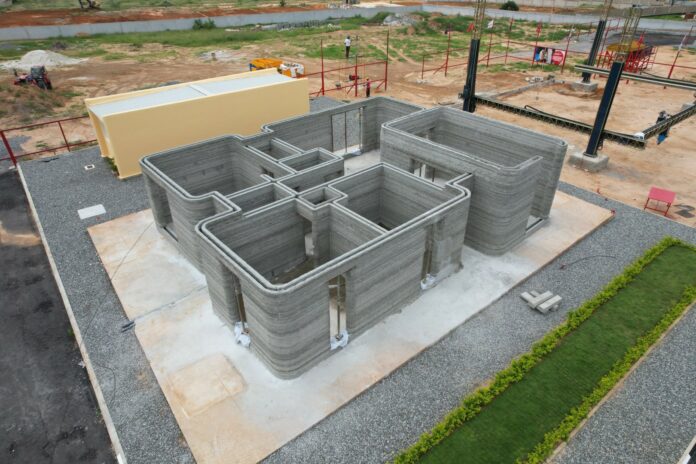Construction company Power2build just completes what is described as the largest 3D printing building in Angola. If you are a regular reader of 3D ADEPT, you probably know that the company was announced as one of the first that should rely on COBOD’s new solution to achieve 90% cost reduction in 3D concrete printing materials – which it did in this new construction. At the time, Power2build just completed the 3D printing of a 53 m2 (570 sf) house in the country.
This new building is a 140 m2 house that holds a suite, two bedrooms, three bathrooms, a dining room, and a living room. As the three bathrooms indicate, this is not a social housing project, but rather a house showcasing the design and architectural possibilities of 3D printed buildings.
While the first house was printed in 48 hours, the second house with 140 m2 was printed in 30 hours. This equates to a 4,5 times improvement in productivity. In addition to this, the team was able to both do the printing, and the water and electrical installations at the same time, a press release reads. The construction required the use of the new solution as said earlier – the D.fab material solution – which enables the usage of 99% locally available materials and only 1% Magic Mix supplied by COBOD.
By betting on COBOD’s technology, Power2build ambitions to address the housing shortage in the country.
Interestingly, this large 3D printed building is also one of the first (if not the first) that is not built with for a social purpose in Africa. Most projects we’ve seen so far have been achieved with a social purpose in mind. With this construction, people will see that technology is not exclusively meant for social purposes but also for anyone who can afford it.
Ricardo Almeida, CEO from Power2Build said: “We are very proud of our progress; people were questioning if we couldn’t print bigger. We have now printed a 2,6 times bigger house and in about 2/3 of the time compared to the first house. We improved the speed of execution remarkably, but still believe there is room for improvement. In the future we will only become better at mastering this technology. We are getting more efficient by the day and closer to achieving our vision to deliver better housing at affordable prices to Angolan families.”
So far, it looks like COBOD International’s 3D construction printing technology is dominating the market in Africa, which so far has six 3D printed buildings all done with the company’s technology.
“The company was the first (and only) to print in Malawi, Madagascar, Kenya, and Angola, two of which are schools and four residentials. Later this year COBOD’s customer 14trees will begin printing a double-digit number of houses in Kilifi in Kenya”, a press communication concludes.
Remember, you can post job opportunities in the AM Industry on 3D ADEPT Media free of charge or look for a job via our job board. Make sure to follow us on our social networks and subscribe to our weekly newsletter : Facebook, Twitter, LinkedIn & Instagram ! If you want to be featured in the next issue of our digital magazine or if you hear a story that needs to be heard, make sure you send it to contact@3dadept.com






